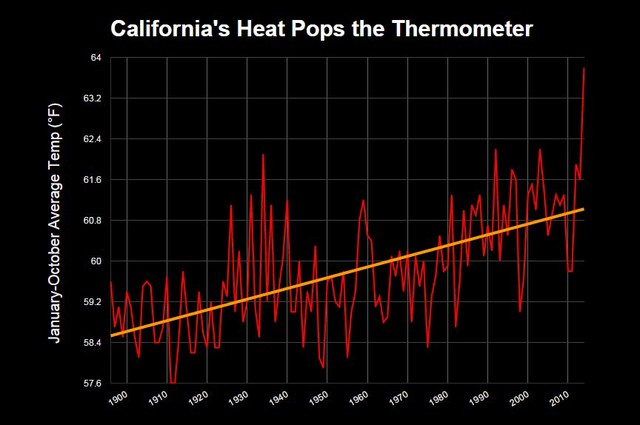California’s ‘Hot Drought’ ranks worst in at least 1,200 years
By Tom Randall
5 December 2014 (Bloomberg) – Record rains fell in California this week. They’re not enough to change the course of what scientists are now calling the region’s worst drought in at least 1,200 years. Just how bad has California’s drought been? Modern measurements already showed it’s been drier than the 1930s dustbowl, worse than the historic droughts of the 1970s and 1980s. That’s not all. New research going back further than the Viking conquests in Europe still can’t find a drought as bad as this one. To go back that far, scientists consulted one of the longest records available: tree rings. Tighter rings mean drier years, and by working with California’s exceptionally old trees, researchers from University of Minnesota and Woods Hole Oceanographic Institute were able to reconstruct a chronology of drought in southern and central California. They identified 37 droughts that lasted three years or more, going back to the year 800. None were as extreme as the conditions we’re seeing now. One of the oddities of this drought is that conditions aren’t just driven by a lack of rainfall. There have been plenty of droughts in the past with less precipitation. (The drought of 1527 to 1529, for example, was killer.) What makes this drought exceptional is the heat. Extreme heat. Higher temperatures increase evaporation and help deplete reservoirs and groundwater. The California heat this year is like nothing ever seen in modern temperature records. The chart above shows average year-to-date temperatures in the state from January through October for each year since 1895. California’s drought has withered pastures and forced farmers to uproot orchards and fallow farmland. It may cost the state $2.2 billion this year, with 17,100 jobs lost and 428,000 acres of land left unplanted. Tensions are still running high between farmers and salmon fishers, who rely on the same waters. Young salmon even qualified for migration assistance this year — via tanker truck — when river levels were too low to make the swim. The effects of prolonged drought are cumulative. Maps from the U.S. Drought Monitor below show the worsening of conditions over the last three years.
More than half of the state remains in “exceptional drought” (crimson). It’s a distinction marked by crop and pasture losses and water shortages that fall within the top two percentiles. Record rainfalls recorded across the state this week — including in San Francisco and Los Angeles — did little to overcome the state’s moisture deficit, the National Drought Mitigation Center reported yesterday. [more]
California’s ‘Hot Drought’ Ranks Worst in at Least 1,200 Years

